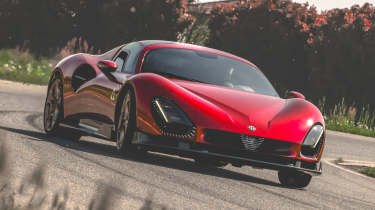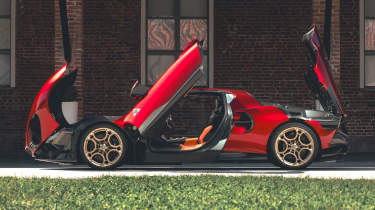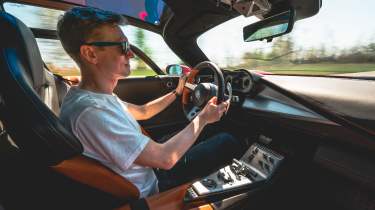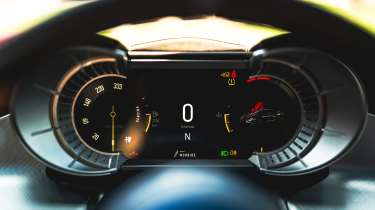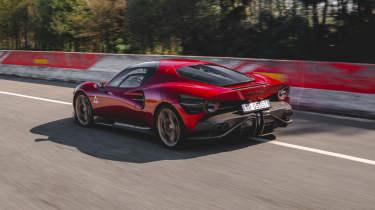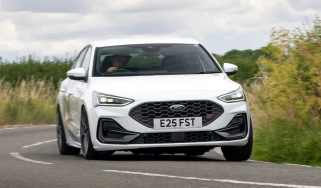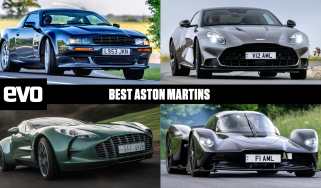Alfa Romeo 33 Stradale 2025 review – a rare Italian jewel beyond compare
What’s Alfa Romeo’s near-£2m hand-built supercar like to drive? We find out, on the Balocco test track
Here’s a novel thought. Does it actually matter what the Alfa Romeo 33 Stradale is like to drive? Seeing one in real life carries Halley’s Comet odds: appositely, only 33 cars will be built, each tailor-made for individual customers around the world. Alfa Romeo hasn’t officially disclosed a price, but it’s understood to be around the £1.5m mark (before taxes). Nonetheless, the production run is sold out.
It doesn’t really exist in the ‘normal’ car universe; it’s a machine launchedinto the weird, extraordinary orbit of the ultra-wealthy. Perhaps some owners will drive their 33 Stradales far and wide, but it would be understandable (and unsurprising) if the cars spend much of their time tucked away in secure, climate-controlled storage. And perhaps the fact that a brand-new Alfa Romeo supercar exists, in 2025, is special enough. If it’s merely okay to drive, that would be, well, okay, wouldn’t it? Because, look at it.
Under the sunlight here at Alfa Romeo’s Balocco test track in northern Italy, it’s a spellbinding object to behold. Of course what it’s like to drive matters. If it turned out to be a show pony without substance – a synthesised, auto-tuned cover version of the original 33 Stradale of the 1960s – it would undermine the history, the romance, the sense of occasion that makes it desirable in the first place.
So, good news: on-track, with sun-warmed air coursing through the vents artfully carved into the Stradale’s haunches, brawny turbocharged V6 soaring to its red line, and low-lying nose pointed at the snow-capped horizon, the 33 feels very good to drive indeed.
More reviews
Group tests
- Alpine A290 v Alpine A110 – how much DNA do they really share?
- Ariel Atom 4R v Caterham Seven ‘evo25’: power-to-weight heroes go head-to-head
- Ariel Atom 4 v Caterham Seven 310R v Lotus Elise Cup 250
- £200,000 supercar shoot-out: AMG v Aston Martin v Maserati v McLaren
- Audi Quattro, RS2 and RS3: five-cylinder icons head-to-head
- Who makes the best GT car? Aston Martin v Bentley v Maserati
- Caterham Super Seven 600 v Super Seven 2000
- Corvette Stingray v Porsche Cayman GTS v Audi R8 RWD
- Volkswagen Golf GTI Clubsport v Cupra Leon 300 – what's the best mainstream hot hatch?
- Great Ferrari hypercars driven: 288 GTO, F40, F50 and Enzo head-to-head
In-depth reviews
- Abarth 600e 2025 review – Italy gives the Alpine A290 something to worry about
- Alpine A110 review – the sports car Lotus should be building
- Aston Martin Vantage 2025 review – a thrilling Mercedes-AMG GT and 911 Turbo S alternative
- Used Audi RS2 (1994) review – an unsung '90s hero you can own for £40k
- Audi R8 (2015 - 2024) review – the ultimate soft-focus supercar
Long term tests
- Abarth 695C Turismo Fast Fleet test – living with the charming Italian hatch
- Alfa Romeo Giulia Veloce Fast Fleet test – living with the sharp Italian saloon
- Alpina B10: end of term report
- Alpina B10
- Aston Martin Vantage (2006) Fast Fleet test – living with a £30k V8 Aston
- Caterham Seven evo25 Fast Fleet test – living with a track car for the road
- Caterham Seven evo Edition revealed – bespoke 420R joins the Fast Fleet
- Cupra Leon 300 Fast Fleet test – living with Spain's 300bhp hot hatch
- Cupra Ateca VZN Fast Fleet test – four months with Cupra's hot crossover
- Cupra Leon Estate 310 4Drive Fast Fleet test – living with the 306bhp hot estate
Review
- New Bentley Batur 2023 review – can it possibly be worth £1.65m?
- 2023 Chevrolet Corvette C8 Z06 review – the American 911 GT3?
- BBR Supercharged Mazda MX-5 (ND) 2023 review – tuned 250bhp roadster driven
- MG4 Trophy 2023 review
Reviews
- Abarth 695 75 Anniversario edition 2024 review – a fitting send-off for Abarth’s hot supermini?
- Abarth 500e 2023 review
- AC Cobra 378 Superblower MkIV 2021 review – another V8 Cobra, but with a GM heart this time
- Acura Integra Type S 2024 review – a Honda Civic Type R with added restraint
- Alfa Romeo Giulia 2025 review – get one while you still can
- Alfa Romeo 33 Stradale 2025 review – a rare Italian jewel beyond compare
- Alfa Romeo SZ: history, review and specs of an icon
- Alfa Romeo 1750 TBi
But before delving deeper into the driving experience, it’s worth delving into the backstory. Alfa Romeo’s designers and engineers have presumably been sketching ideas for mid-engined supercars from time immemorial because that’s what passionate car people do, but why has Alfa as a company – or more accurately, the board at the Stellantis parent-company mothership – taken the decision to make it a reality now?
The drive to create a halo supercar came from former Alfa Romeo CEO Jean-Philippe Imparato. When the idea was put to the rest of the Stellantis board ahead of 2022, it was met with an almost unanimous volley of ‘no’s, apart from one ‘maybe’ from then Stellantis chief Carlos Tavares, who saw it as a chance to prove the organisation’s capability to create a high-tech, low-volume, start-up-style project.
A start-up in the truest sense: not since the 4C in the 2010s has Alfa Romeo created a carbon-monocoque, mid-engined car. It was starting almost from zero, with handy access to the building blocks of the Maserati MC20 within the Stellantis fold.
Ultimately, the 33 was given the green light on the proviso that 33 customers could be found. The task of finding the customers and pushing the Stradale from hypothetical to reality fell to head of strategic projects Cristiano Fiorio. It’s fair to say he embraced it wholeheartedly. ‘I have three children – two kids and the 33 Stradale,’ he smiles, when we meet him ahead of our drive. He needed to secure customers’ deposits, simultaneously assuring them their money was refundable should the car not make production after all, and that it definitely would. Tricky when, at that stage, he had a piece of paper to show them rather than a physical prototype.
Where do you start finding 33 potential customers for an ultra-limited multi-million-euro supercar? Logically, he began tracking down owners of the original 33 Stradale, theorising that they might also be interested in its successor. The 1967-1969 Stradale was an achingly beautiful road-going version of the Tipo 33 Le Mans racer, designed by Franco Scaglioni. At £6100 (£141,500 in today’s money), it was the most expensive car in the world. It’s a little more valuable today: only 18 were made.
> Alfa Romeo 4C – the car world's greatest misses
Fiorio doesn’t disclose how many original 33 owners took the plunge but, despite the new car’s c2million euro price, it ultimately attracted more buyers than its 33 build slots. Having criss-crossed the world to build relationships with each potential customer, Fiorio describes, with tangible anguish, personally calling those who missed the cut. ‘When I went home that night, I cried.’
A condition of sale is that no two new 33 Stradales can be the same. Each customer has gone through a bespoke speccing process, most at the Sala del Consiglio inside the Alfa Romeo Museum in Arese: the room in which the original 33 was signed off. In a different room within Alfa Romeo’s Centro Stile design centre at Turin, we go through a compacted version of the same process, speccing ‘our’ (sadly virtual) 33 Stradale.
Senior product manager Francesco Busceti and design project manager Alessandro Maccolini talks us through the endless permutations. On-screen, a 33 Stradale CAD model is rendered with our design choices in real time: a demure Midnight Blue body with satin gold wheels and biscotto interior, and the evo logo engraved on one of the steering wheel spokes, if you’re interested.
Aside from bespoke liveries, trims and wheel designs, customers can choose more complex options: different configurations for the air outlets in the rear arches and tail, for example, and the style of the front shield: a retro design like the ’60s 33, or a more progressive 3D shape as on the car tested here (which will find its way onto future Alfa Romeo models).
Inside, there are two ‘suggested’ themes, a brushed aluminium and leather ‘Tributo’ combo or more modern carbonfibre and alcantara ‘Corse’ scheme, but customers can blend the two or request alternative materials.
Across town, the real customers’ 33s are already in production at Carrozzeria Touring Superleggera. Alfa Romeo does not have the capacity to assemble this specialised supercar in-house, and outsourcing production to Touring is a practical solution as well as a romantic, historically resonant one: during early and latter periods of its 99-year history, Touring has constructed various storied Alfas including the 1938 8C 2.9 Le Mans car, the experimental Disco Volantes of the ’50s, and the 2013 modern interpretation of the Disco Volante, based on 8C Competizione running gear.
It’s here, stepping inside one of Touring’s spotless but unassuming industrial buildings, that we clap eyes on the 33 Stradale for the first time: a customer car undergoing final checks lies just beyond the doorway. It looks at once compact and imposing: more than 2m wide but less than 1.2m tall. You can see the Maserati MC20’s hard points within its graceful silhouette but it’s very much a car with its own identity. The helix-hinged doors are raised and an evocative scent of leather spills from the interior.
The 33’s carbon chassis – shared with the Maserati – is built by Dallara before arriving at Touring. Constructing the body-in-white is the longest, most complex process: ‘All of the car is built around the roof,’ explains Maccolini. ‘If the roof is wrong, the whole car is wrong. The body parts are very few, but very large,’ he adds. ‘It’s simple but complicated.’ As with the rest of the body, the front and rear clamshells – or cofangos – are made from single large sections of carbonfibre, painstakingly fitted and checked. There is no automation. Currently, one 33 is being completed per month. The first customer car was delivered on 17 December 2024; an apt date as the project was signed off on 17 April 2023, which gives some idea of the rapidity of this car’s conception and development.
While much of the 33’s architecture is shared with the MC20, its suspension is different, using the same semi-active dampers as the Giulia Quadrifoglio, plus rear-wheel steering, a feature not offered by Maserati. The 3-litre twin-turbo V6, driving the rear wheels only, develops the same 621bhp output as the MC20’s Nettuno unit.
Is it a Maserati or an Alfa engine? Fiorio explains that the MC20’s engine was developed from the Giulia Quadrifoglio’s V6 (which itself was created with input from Ferrari), with the biggest step-change from Giulia to MC20 being the Maserati’s ‘pre-chamber’ combustion system. So it’s a complex Italian bloodline. Incidentally, the MC20 was originally intended to be an Alfa Romeo supercar, part of a plan initiated by the late Sergio Marchionne, before circumstances changed and it was reassigned to Maserati.
The 33’s shape is remarkably clean, without fixed wings or active aero and a slippery 0.375 drag coefficient. Eye-socket-like intakes in the headlight area cool the brakes and channel airflow, while the door mirror support helps marshal air along the car’s flanks, where it’s divided into the upper and lower radiators by the side intakes, the subject of hours of fine-tuning in the wind tunnel.
> Alfa Romeo Tipo 103 – dead on arrival
As a special ‘bottega’ project, there was neither time nor resource for multiple 33 Stradale prototypes. Besides a static ‘mock-up’, one physical, driveable prototype 33 Stradale was built: car no. 00. That’s the car we’ll be driving: the only functional 33 Stradale that exists outside of the 33 customer cars.
Prototypes are often rough, untidy machines. As we arrive at Balocco the next morning, it’s clear car no. 00 is anything but. In the soft morning light, parked in Balocco’s picturesque courtyard, it’s a captivating creation, more show car than validation car. In fact, its role is both – a concept-car-standard demonstrator, and a hard-working test car, racking up more than 3000km at Balocco, Nardo and beyond. It recorded a spookily appropriate 333kph (207mph) top speed at the Nardo bowl, and here at Balocco its test drivers have included former Alfa Romeo Sauber F1 pilot Valtteri Bottas. He’s one of the 33 customers, incidentally; car no. 17 will be his.
The interior is as striking as the exterior. Since the doors take a large section of the roof with them when they’re raised, you have a large, curved aperture through which to drop into the ridged leather seat. The door needs a hefty pull to close. Once thunked shut, you find yourself in an airy interior; the glass panels in the top of the doors let a generous amount of light through the roof.
The sunshine dances over the brushed aluminium on the centre console, dash and steering wheel, though the doors’ tinted glass ensures it never dazzles. There are no buttons on the wheel. Instead, tactile, crank-shaped rocker switches are the principal switchgear on the centre console and on a separate panel mounted in the roof. Two gigantic switches put the car in gear, and toggle between manual, auto and reverse. Thereafter, the eight-speed, dual-clutch transmission is controlled via the enormous, samurai-blade-like paddles behind the wheel, as per the Giulia Quadrifoglio.
Feedback from the 33’s clients suggested they wanted a break from touchscreens and haptic pads (good on them), so there’s no visible infotainment screen inside the Stradale – it’s hidden neatly behind the centre console. When you need or want to access it, you flick the schermo switch and the screen slides neatly into position. Speaking of electric components, you might remember that the 33 was initially offered with either the V6 or a fully electric powertrain. Two customers initially opted for the EV before eventually changing their minds; all 33 cars will be petrol-powered.
The engine starts via a push/turn of a rotating switch. Alfa Romeo’s engineers wanted the 33 to sound as evocative as possible and studied the frequencies from the car they considered to be the best-sounding Alfa of recent times: the 8C Competizione. Through tuning the length and diameter of the exhaust system, the frequencies throughout the V6’s rev-range match the 8C’s as closely as possible. Mind you, there is an 8C Spider trundling around Balocco’s courtyard and it sounds like a window into heaven. Two extra cylinders and no turbochargers is tricky to compete with.
The 33 does sound good as we pull away, however – a brusque but cultured tone, punctuated by occasional breathy gasps from the turbos. It’s a more vocal, textured-sounding car than the MC20. We’re padding through the access roads to the test track, following an Alfa Romeo test driver in a Giulia GTA. Balocco is used by Stellantis and the wider automotive industry for a whole host of testing purposes but appropriately we’re heading for the ‘Alfa Romeo Circuit:’ the very first circuit constructed here in the early ���60s, for the purpose of testing Alfa road and race cars, including the original Tipo 33.
Building speed gradually on track, the 33 is a relatively user-friendly car to acclimatise to. The view ahead over the low nose and through the wraparound glass either side gives it an airy feel, and though you can barely see anything through the polycarbonate engine cover behind, as per the MC20 the rear-view mirror can be toggled to show a very effective camera display.
The steering wheel is a lovely thing to hold, with its slim, leather-bound rim and cool-to-the-touch alloy spokes. The steering itself is slower in rate and response than in many modern performance cars – an observation rather than a criticism, although the 33 changes direction a little more languidly than you might expect in slower corners; the rear-steer operates purely for stability in high-speed corners, turning the rear wheels in the same direction as the fronts.
The pace builds and the hazards flash automatically on the Giulia ahead as its driver works its brakes hard. The 33’s brake pedal needs a good firm press. Like the Giulia Quadrifoglio, the 33 employs a brake-by-wire system. Initially the carbon-composite brakes (with six-piston calipers at the front) feel a little remote, but stopping power is mighty, particularly as temperature builds. You hear the faint sshhh of pads against composite discs as your foot brushes the pedal, like cupping a seashell to your ear. Perhaps a facet of the stiff carbon construction transmitting sounds to the cabin, you also hear gravel ping against the wheelarches too, a little like in a racing car.
It’s stable like a racing car under hard braking too, unlike some mid-engined cars which can get a little flighty. But in other respects the 33 definitely feels like a car geared for road rather than track – as it was conceived from the outset. ‘We want it to be the kind of car you could drive to take a coffee with,’ says Fiorio. But it’s certainly extremely capable on track – especially when switched from its standard Strada drive mode to Pista.
The damping is notably soft and supple in Strada, and still has a reasonable amount of ‘give’ in Pista (you can mix and match damper settings and drive mode via another toggle switch). In Pista, the 33 is more eager in every respect – engine, gearshifts, damping – and its digital instrument panel twists the central tacho for a 12 o’clock red line and flanks it with essential temperatures, including brakes. Alfa clearly meant the 33 to have the potential to be driven hard. The shift lights are integrated into the tacho, the rifled sections of the screen’s telescopic shroud acting as light guides.
The Giulia ahead is an invaluable pathfinder, as I’ve no idea which way the circuit goes. It’s a long lap, narrow and bumpy in places, with low-speed snake-coil switchbacks and ballsy fast corners too, some designed to replicate Monza, Le Mans and Spa’s greatest curves. As is the way with mid-engined cars, the 33 can move around if you have a confidence lift mid-corner, but it’s ultimately a safe, stable car. The traction control errs on the side of caution and can be a little abrupt when it cuts in over bumps, but another click of the switch accesses a further Pista ESC Off mode.
The differential is electronically controlled but it’s a true limited-slip diff, as opposed to the torque-vectoring e-diff in the original Giulia Quadrifoglio. The baseline handling trait is toward understeer – not a bad thing, it’s a road car after all – but with more laps it’s clear this is a car you can play with and it won’t bite. It’s on your side. Relocating to Balocco’s Langhe track, which replicates a country road, the 33 is also well resolved over crests and undulations (even with fresh air under its tyres over a light yump).
The Bridgestone Potenza Sports are ‘off-the-shelf’ tyres rather than bespoke developed for the car (just as the GMA T.50, for example, uses Michelin Pilot Sport 4S tyres). They heat up nicely on this warm day, and telegraph their limits well.
Being dispassionate, I’d subjectively say less rarefied but also rear-drive, non-hybrid, turbocharged supercars such as the McLaren 750S or a Ferrari 488 or F8 Tributo, would be faster and even more thrilling here at Balocco. Although the 33’s dynamics are very impressive and rewarding, there’s a nagging sense they could be even more polished with more development time and budget.
But this is the opposite of a dispassionate car. If you were to look at it rationally, you could buy a Maserati MC20 and save yourself a million quid and change. But it has a different personality from the MC20, both as an entity and in the way it drives. Back in the UK, we test an MC20 within days of the 33, and the two cars do truly feel very different to operate though they share so many mechanicals.
Aside from the car itself, the 33’s 33 owners are paying for an experience: the 1:1 access to top-table management, designers and engineers inside Alfa and Touring Superleggera, the process of speccing a one-of-a-kind car, and the immersion in all the romance and resonance of creating a little piece of Alfa Romeo history. Leaving all that aside, the 33 Stradale is a great driving experience.
Alfa Romeo is generally spoken of in the past tense in terms of truly great cars (current Giulia and Stelvio Quadrifoglios notwithstanding). The 33 puts it back into current conversation as a top-tier sporting brand. Further limited-run Alfa Romeo bottega projects will follow, each similarly limited to 33 cars. Such cars might exist in the vaguely irrelevant stratosphere of the ultra-rich but, somehow, they make the wider automotive world a little bit richer for their existence.
Price, rivals and specs
As above, the 33 Stradale is thought to cost from around £1.5million plus local taxes, before getting into the in-depth specification process. Being such a rare machine that's as much a piece of art as it is a mode of transport, objective comparison feels crude. But cars of its like from other marques include the Aston Martin Valour and Bentley Batur – ostensibly very different cars, albeit ones that tread the same rarified, semi-coachbuilt ground as the 33 for about the same money. A cynic might say its close relative, the MC20, might be a good alternative too, at least on a functional level, for almost a tenth of the price.
| Engine | V6, 2992cc, twin-turbo |
|---|---|
| Power | 621bhp @ 7500rpm |
| Torque | 538lb ft @ 3000-5500rpm |
| Weight | 1550kg |
| Tyres as tested | Bridgestone Potenza Sport |
| 0-62mph | 3.0sec |
| Top Speed | 207mph |
| Price | From £1.5m + taxes |
